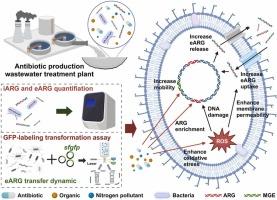抗生素生产废水处理过程中细胞外抗生素耐药基因的分析:发生、转化动力学和潜在宿主
IF 11.3
1区 环境科学与生态学
Q1 ENGINEERING, ENVIRONMENTAL
引用次数: 0
摘要
在废水处理过程中,抗生素耐药基因(ARGs)在细胞内和细胞外的传播已引起越来越多的关注。抗生素生产废水(APW)含有高浓度的抗生素和已知可诱导细胞外ARGs (eARGs)转化并可能促进抗生素耐药性传播的有机物。在本研究中,研究了eARGs在全规模APWTP处理厂(APWTP)中的存在、转化动态和潜在宿主。游离eargs (f-eARGs)在废水中普遍存在(5.0×106 copies/mL),占总ARGs的54.9%。与城市污水相比,APW显著提高了egg的转化能力,且在进水浓度水平下,其效果显著大于抗生素。这种促进作用可能是由于氧化应激和细菌膜渗透性的增加,并随着常规废水污染物(如COD和NH3-N)的去除而降低;然而,这种效果在治疗后仍然存在。基于细胞分选和高通量测序,一些机会致病菌,如假单胞菌、窄养单胞菌和不动杆菌,表现出摄取eARGs的高度倾向,对人类健康构成更大的威胁。这些发现强调了eARGs对wtp中抗生素耐药性传播的重要贡献,特别是在治疗APW时。本文章由计算机程序翻译,如有差异,请以英文原文为准。

Profiling of extracellular antibiotic resistance genes during antibiotic production wastewater treatment processes: Occurrence, transformation dynamics, and potential hosts
The propagation of antibiotic resistance genes (ARGs) in both intracellular and extracellular forms during wastewater treatment processes has garnered increasing attention. Antibiotic production wastewater (APW) contains high concentrations of antibiotics and organics known to induce the transformation of extracellular ARGs (eARGs) and potentially facilitate antibiotic resistance transmission. In this study, the presence, transformation dynamics, and potential hosts of eARGs in a full-scale APW treatment plant (APWTP) were investigated. Free-eARGs (f-eARGs) were prevalent in the effluent (5.0 ×106 copies/mL), comprising 54.9 % of total ARGs. APW significantly increased the transforming ability of eARGs compared to municipal wastewater, with this effect being significantly greater than that of the antibiotics at influent concentration levels. This promotion effect was likely due to increased oxidative stress and bacterial membrane permeability, and reduced concomitantly with the removal of conventional wastewater pollutants (e.g., COD and NH3-N); however, such effect persisted after treatment. Based on cell sorting and high-throughput sequencing, several opportunistic pathogens, such as Pseudomonas, Stenotrophomonas, and Acinetobacter, demonstrated a heightened propensity to uptake eARGs, posing a greater threat to human health. These findings underscore the significant contributions of eARGs to the spread of antibiotic resistance in WTPs, particularly when treating APW.
求助全文
通过发布文献求助,成功后即可免费获取论文全文。
去求助
来源期刊

Journal of Hazardous Materials
工程技术-工程:环境
CiteScore
25.40
自引率
5.90%
发文量
3059
审稿时长
58 days
期刊介绍:
The Journal of Hazardous Materials serves as a global platform for promoting cutting-edge research in the field of Environmental Science and Engineering. Our publication features a wide range of articles, including full-length research papers, review articles, and perspectives, with the aim of enhancing our understanding of the dangers and risks associated with various materials concerning public health and the environment. It is important to note that the term "environmental contaminants" refers specifically to substances that pose hazardous effects through contamination, while excluding those that do not have such impacts on the environment or human health. Moreover, we emphasize the distinction between wastes and hazardous materials in order to provide further clarity on the scope of the journal. We have a keen interest in exploring specific compounds and microbial agents that have adverse effects on the environment.
 求助内容:
求助内容: 应助结果提醒方式:
应助结果提醒方式:


